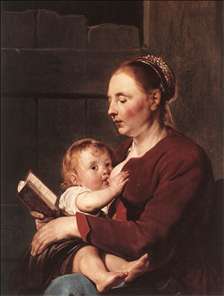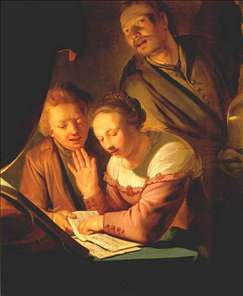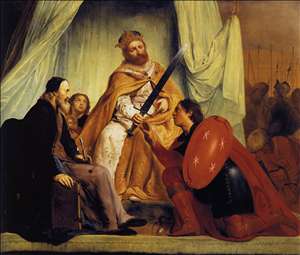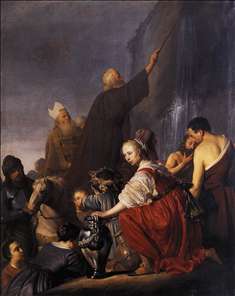The eldest son of the history and portrait painter, Frans Pietersz de Grebber (1572/73-1649), and Hillegart Fredericxdr van Lijnhoven (d. 1643), Pieter de Grebber was born in Haarlem in ca. 1600. His sister Maria (ca. 1602-1680) and brother Albert (1613/14 - after 1649) also became painters, and his brother Maurits (c. 1604-1676) became a goldsmith. The family was devoutly Catholic and had close ties to the clergy. Frans de Grebber even sheltered the Amsterdam priest, Simon van Linteloo, in his house and permitted him to celebrate mass in their home. Pieter was a friend of the priest of the Begijnhof (a lay-order religious community), the noted musicologist Jan Albertsz Ban (1597/98-1644), and not only shared his interest in music, but also bought a house in the Beguinage in 1634, living there for the remainder of his life.
Pieter first studied with his father before being apprenticed to the renowned history painter, draughtsman, and printmaker, Hendrick
Goltzius. Frans de Grebber served as Peter Paul
Rubens s agent, and young Pieter accompanied his father to Antwerp in 1618, where he met the great Flemish master. His earliest dated paintings are of 1622 (
Mother and Child, Frans Halsmuseum, Haarlem; and Caritas, Museum of Fine Arts, Houston), but he did not join the Haarlem guild until 1632. Although it is undocumented, De Grebber probably worked in Denmark and his Belshazzar s Feast of 1625 came from Gottorf Castle in Schleswig, which was then Danish. Frans de Grebber was also a member of the Schoon-Vaerders Guild in Haarlem, a fraternal order originally founded by merchants who traded with Skane in southern Sweden, which also was then part of Denmark.
In 1628 De Grebber painted his large Acts of Charity (Frans Halsmuseum) and Jacob, Rachel and Leah (Frans Halsmuseum) for the Old Men s Almshouse in Haarlem. Two years later he was commissioned by the municipal authorities to design a tapestry of the Conferring of the Cross on the Haarlem coat of arms and also apparently a painting of the
Conferring of the sword on the Haarlem coat of arms. In 1637 he executed Elisha refusing Naaman s gifts (Frans Halsmuseum) for Haarlem s Leper House.
De Grebber produced decorations for several royal palaces owned by the stadholder Frederik Hendrik, including Honselaarsdijk near Naaldwijk (1638), the Oude Hof, now Noordeinde Palace in The Hague (1646), and the Oranjezaal in
Huis ten Bosch, also in The Hague (1648-1650) He also executed altarpieces for Flemish churches (Raising of Lazarus dated 1623, Onze Lieve Vrouwekerk, Bruges; and the Assumption dated 1648 from Sint Pieterskerk, Ghent, now in the Museum van Schone Kunsten, Ghent) and for schuilkerken, or hidden churches (The deposition dated 1633, Rijksmuseum, Amsterdam). Among De Grebber s approximately twenty surviving portraits are several of prominent Catholic priests.
De Grebber won the praise of Philips Angel (Lofder Schilderkunst 1642) for his command of human anatomy. He also seems to have prospered financially, paying off the house that he purchased for 3,530 guilders in only four years and standing as guarantor for several of his father s business transactions. He also published a set of rules of art in 1649: Regulen: Welcke by een goet Schilder en Teyckenaer geobserveert en achtervolght moeten werden; Tesamen Qhestelt tot lust van de leergieriahe Discipelen (Rules to be observed and followed by the good artist and draughtsman, compiled for the pleasure of students with a thirst for learning).
De Grebber never married and died some time between 24 September 1652 and 29 January 1653, when his home was sold. He made a will, but the document is lost and no inventory of his estate survives. In addition to his activity as a painter, De Grebber left many drawings and several etchings.
Although only now regaining historical recognition, Pieter de Grebber was a highly regarded history and portrait painter in his day and distinguished himself as a pioneer of Haarlem classicism with a characteristic clarity and order in his designs, pale hued palette, and painterly execution in his mature works. His early paintings attest to his admiration for the Utrecht Caravaggisti, and he clearly had firsthand acquaintance with the achievements of both
Rubens and
Rembrandt, but his own style, which he had perfected by the mid-1620s, was unique, not merely an amalgam of Northern and Southern Netherlandish elements.









